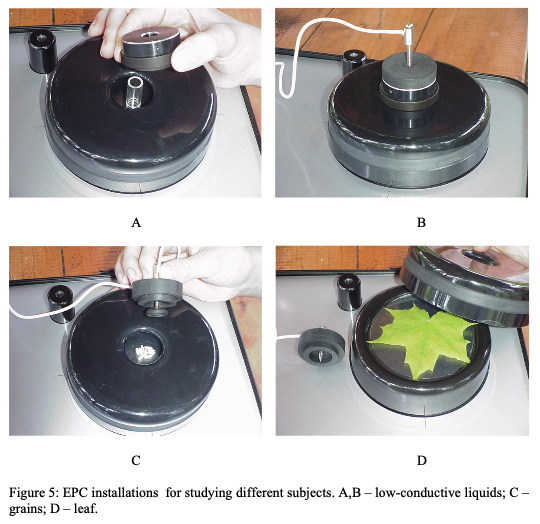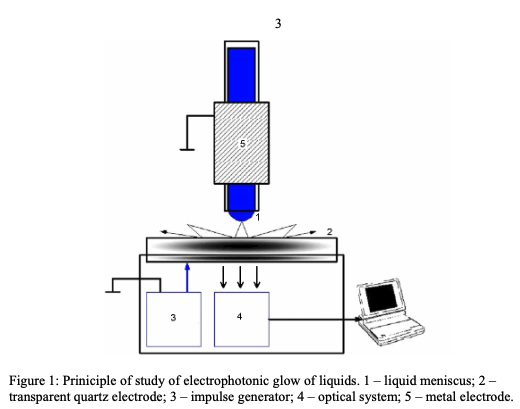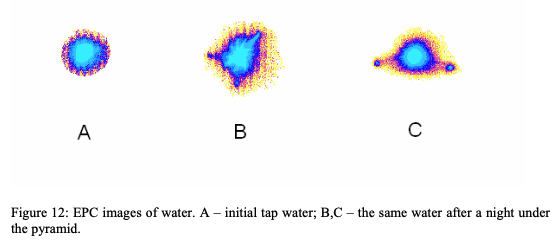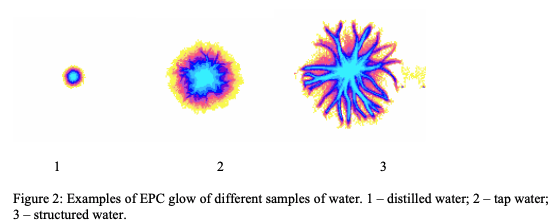Analysis of Stimulated Electrophotonic Glow of Liquids
Korotkov, K, Orlov, D
Department of Computer Science, St. Petersburg Federal University “ITMO”, St. Petersburg, Kronverski prospect 49, 197101
Key words: electrophotonics, photons, structured water, water energy, GDV, water quality, memory of water
Summary
New method of monitoring water properties – dynamic Electrophotonic (EPC) analysis – has been developed. It is based on measuring and computer processing of stimulated by electromagnetic field photon emission from the water surface. Technology is based on well- known gas-discharge visualization (GDV) method. Numerous experiments demonstrated high sensitivity of the EPC analysis for detecting weak transformations of water under the influence of electromagnetic fields, air, light, and other subtle factors. Difference between natural and synthetic stuff was detected by the EPC method. Different liquids, such as blood, saliva, microbiological cultures, and oils may be studied by this approach as well. There are a lot of evidences which allow to propose that EPC image properties is obviously determined by the structure of the near-surface clusters, which means that the electrophotonic method is one of the informative methods for study of structural properties of liquids.

Introduction
Currently considerable attention is being focused on the study of the structural properties of water and the possibility of data transfer through water. A lot of controversial information we may find concerning the memory of water (Johansson, 2009). According to the viewpoint that has shaped, the phenomena observed during the experiments are determined by the processes of clusters and clathrates formation, mainly at the atoms of admixtures (Del Giudice, Vitiello, 2006). The task of introducing these notions into the scope of contemporary scientific thinking requires, first of all, a set of probative and reproducible experimental facts. Water is a complex subject of study, and its properties depend on a great number of factors; this requires that several independent techniques should be used in parallel, and that new informative methods for the study of water properties should be developed and introduced into practice (Voeikov, Del Giudice, 2009).
The high degree of informativeness of the Dynamic Electrophotonic Capture (EPC) Analysis based on Gas Discharge Visualization (GDV) method (Korotkov et.al, 2002, 2010; Web ref.1) applied for studying liquid-phase subjects was first demonstrated during the study of the glow of microbiological cultures (Gudakova et al, 1990), blood of healthy people and cancer patients (Korotkov et al, 1998), reaction of blood to allergens (Sviridov et al, 2003), homeopathic remedies of 30С potency (Bell et al, 2003), and very small concentrations of various salts (Korotkov, Korotkin, 2001). The differences between the glow parameters of the NaCl, KCl,

NaNO3 and KNO3, solutions and distilled water were observed until the 2-15 dilution; however, the dynamic trends of the 2-15 dilution and distilled water still had different directions.
Great interest has been roused by the studies directed at detecting the differences between the glow of natural and synthetic essential oils with identical chemical composition (Korotkov et al, 2004). The oils were analyzed in order to detect possible differences between oils that were obtained by means of natural and synthetic processes, between oils of organic and regular origin; between oils obtained in different climatic conditions and extracted by means of different methods; between oils with different optical activity; between fresh oils and oils that were oxidized by various methods. The combinations of oils under study did not show any statistically significant differences when analyzed by means of the gas chromatography method.
Technique
The study of Electrophotonic parameters of liquids is based on using a commercially produced instrument “GDV Camera”, which is manufactured by the KTI company, St. Petersburg (Web ref. 2). This instrument is well-known for analyzing stimulated photon emissions from human fingers, which is being used for health and well-being diagnostics (Measuring 2002), analysis of athletes (Bundzen et al. 2005), of altered states of consciousness (Bundzen et al. 2002. Korotkov et al. 2005), of the influence of music (Gibson, Williams 2005) and Qigong to people (Rubik, Brooks 2005), as well as of geo-active zones (Hacker et al. 2005) and minerals (Vainshelboim et al. 2005).

When the EPC parameters are measured for liquid subjects, a drop of the liquid is suspended at 2-3 mm distance above the glass surface of the optical window of the device, and the glow from the meniscus of the liquid is registered (Fig.1). The volume of the liquid is about 5*10-3 ml. The temperature is kept in the range 22-24 C, the relative humidity is maintained from 42% to 44%. The train of triangular bipolar electrical 10 mcs impulses of amplitude 3 kV at a steep rate of 106 V/s and a repetition frequency of 103 Hz, is applied to the conductive transparent layer at the back side of the quartz electrode thus generating an electromagnetic field (EMF) at the surface of the electrode and around the drop. Under the influence of this field, the drop produces a burst of electron-ion emissions and optical radiation light quanta in the visual and ultraviolet light regions of the electromagnetic spectrum. These particles and ions initiate electron-ion avalanches, which give rise to the sliding gas discharge along the dielectric surface (Korotkov, Korotkin 2001). A spatial distribution of discharge channels is registered through a glass electrode by the optical system with a charge coupled device TV camera, and then it is digitized in the computer.


1 thought on “Analysis of Electrophotonic Glow of Liquids”